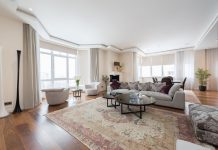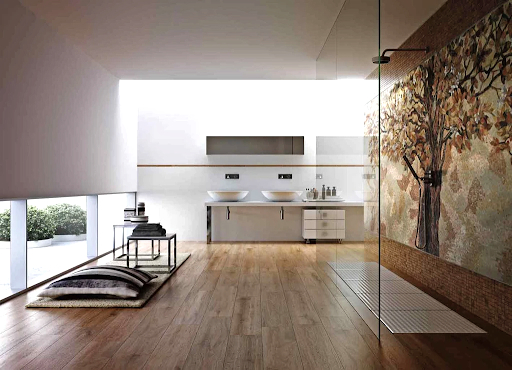There’s something magnetic about a bathroom that feels more like a private spa than a utilitarian space. Luxury bathrooms have long been the domain of glossy magazine spreads and high-end hotels, yet the true secret of their allure isn’t always found in a price tag.
The essence of luxury lies in atmosphere, proportion, and detail, and with the right styling secrets, any bathroom, regardless of its square footage or budget, can achieve that same refined serenity.
Creating a space that looks and feels expensive is about curating sensations: the cool touch of marble, the soft reflection of layered lighting, the subtle rhythm of symmetry.
Designers have honed a language of understated elegance that turns ordinary bathrooms into retreats worth lingering in. And behind every polished image of a spa-like haven, there are clever styling techniques anyone can adopt.
The Power of Restraint
If there is one constant across all luxurious bathrooms, it’s not excess. Designers understand that a sense of calm begins with visual order. The most expensive-looking spaces rarely feel cluttered or chaotic; instead, there is a space to breathe.
Clean countertops, open sight lines, and cohesive materials all contribute to that serenity we associate with luxury hotels and spas.
Achieving this at home begins with subtraction rather than addition. Remove everything that doesn’t serve both a function and an aesthetic purpose.
Everyday items like toothbrushes or cleaning products can live out of sight in drawers or baskets. Once the visual noise is gone, even a modest bathroom begins to feel more intentional and composed.
From there, the palette takes over. Neutral tones, such as warm whites, taupes, soft greys, create a canvas that exudes quiet confidence.
The absence of strong color allows materials and textures to become the focal points. The effect is psychological as much as visual: simplicity allows the mind to rest. That’s the first step toward luxury.
Symmetry and the Art of Balance
One of the most overlooked design principles in bathrooms is symmetry. Walk into any spa or high-end hotel suite, and chances are the space feels intuitively “right.” That’s because symmetry creates a subconscious sense of order.
When mirrors, lighting, and vanities are aligned with precision, the space feels elevated: balanced, composed, and deliberate.
Designers often use pairs to establish that rhythm. Two wall sconces framing a mirror instantly signal sophistication, even if the fixtures themselves are inexpensive.
A single centered rug rather than scattered bath mats brings cohesion to the floor. The visual repetition mimics the calm geometry of boutique spas, where everything feels placed with intent.
Even in small bathrooms, symmetry can be suggested rather than literal. Aligning hardware or using matching storage containers introduces the same sense of harmony. Luxury design is not about abundance, but about control. And few tools are as powerful, or as affordable, as visual balance.
The Texture Equation
A common mistake in budget bathroom design is focusing only on color and ignoring texture. The secret to expensive-looking spaces lies in how materials interact.
Designers layer textures the way stylists layer fabrics on a runway: each surface adds depth and contrast without competing for attention.
Consider how a matte stone floor absorbs light, how a glazed tile reflects it, and how a linen shower curtain softens the hard edges of ceramic.
These tactile differences invite the senses to engage. The interplay between smooth and rough, glossy and matte, warm and cool brings visual richness to even the simplest spaces.
A mosaic wall, for instance, can add extraordinary texture and light play without the cost of slab marble. Its small reflective surfaces create movement and dimension, catching glimmers of light as you pass.
When used sparingly, for example, behind a vanity or in a shower niche, it becomes an accent of understated glamour, proof that luxury can come from thoughtful detail rather than lavish spending.
Texture also extends beyond permanent finishes. Towels, bath mats, and window treatments offer opportunities for soft layering.
Choosing plush textiles in coordinating tones transforms the room into something closer to a retreat than a washroom. The aim is to create sensory contrast: stone that cools the fingertips, cotton that warms them again.

Lighting: The True Luxury
Ask any designer what separates a pleasant bathroom from an extraordinary one, and the answer will be lighting. Poorly lit bathrooms, however well-designed, feel flat. But when lighting is layered, the space glows with warmth and sophistication.
Designers rarely rely on a single overhead fixture. Instead, they orchestrate light in layers: sconces for the face, soft downlights for atmosphere, and perhaps a hidden LED strip beneath a vanity or behind a mirror. The result is dimensionality: a soft choreography of shadows and highlights that flatters both the architecture and the person using it.
You don’t need an electrician’s budget to achieve this. Swapping a harsh bulb for one with a warmer temperature can instantly change the mood.
Installing dimmers allows light to shift from bright and functional in the morning to calm and candle-like in the evening. Even the addition of a table lamp, if space allows, can make a bathroom feel more like a dressing room in a private suite.
Mirrors amplify this effect, doubling the light and expanding the space. The trick is to choose mirrors proportionate to the wall and lighting, ensuring reflections enhance rather than clutter the visual field.
Natural Elements and the Spa Connection
There’s a reason every spa in the world seems to incorporate wood, stone, or greenery. Nature is the ultimate luxury: it soothes the senses and signals authenticity. Designers use natural elements to temper the sterility that bathrooms can easily slip into.
Even a single potted fern or vase of eucalyptus can transform the emotional temperature of the room. The presence of organic materials, such as wooden stools, stone trays, or woven baskets, introduces warmth and tactility. When paired with clean architectural lines, these touches create a balance between serenity and sophistication.
Bathrooms that feel expensive often play with this contrast: the smoothness of marble against the grain of oak, or the cool sheen of chrome beside a woven fiber mat. The human eye craves contrast, it’s what makes luxury spaces feel alive.
Fragrance completes this sensory picture. Diffusers, candles, or even a sprig of lavender by the sink can create an olfactory signature for your space.
Hardware and the Value of Detail
One of the quickest ways to elevate a bathroom is by upgrading the hardware. Designers treat faucets, handles, and showerheads as jewelry for the space: the small, gleaming details that signal craftsmanship.
High-end bathrooms rarely feature standard chrome across every fixture. Instead, they mix metals with intention: brushed brass paired with black matte, or polished nickel offset by marble. The goal isn’t extravagance but distinction. Finishes that feel deliberate instantly read as more luxurious than builder-grade uniformity.
Replacing a faucet or drawer pull might seem minor, but these touches transform the experience of touch and sight.
Even budget fixtures can look expensive when their lines are clean and their finish coordinates with the rest of the design. The key is coherence: every detail should feel like part of the same design language.
For those on a tight budget, paint and polish can achieve similar results. Refinished hardware in an antique tone, or even spray-painted cabinet handles, can mimic high-end materials when done carefully. What matters most is the tactile impression: when a handle feels substantial, the entire room feels more refined.
Mirrors, Glass, and the Illusion of Space
Luxury design is as much about perception as it is about materials. Designers often rely on visual tricks to make small bathrooms feel expansive. Mirrors, glass partitions, and reflective surfaces are their most trusted allies.
A large mirror, running the full width of a vanity, creates an illusion of depth while amplifying light. Frameless glass showers dissolve visual barriers, allowing the room to feel open and airy. The eye moves uninterrupted, perceiving continuity rather than confinement.
Even the strategic use of reflective tiles adds a layer of brilliance. When light glances off these surfaces, it gives the impression of greater volume and vitality.
This manipulation of perception is not deception but artistry. A space feels expensive not necessarily because it is large, but because it feels considered. When every surface contributes to light, reflection, or movement, the bathroom transcends its size.

Cohesion Through Color and Finish
Luxury bathrooms succeed because they speak in one voice. Designers establish a visual hierarchy and stick to it, ensuring that every tone, texture, and finish belongs. Even the most eclectic spaces share a unifying thread, a consistency of tone that reads as intentional.
For homeowners, this means choosing a concise palette and repeating it throughout. If the walls are soft white and the floor grey stone, towels, candles, and accessories should harmonize within that range.
Small accents can provide punctuation: a darker vanity, a brass mirror frame, or mosaic borders framing a shower wall, but these highlights work because the surrounding palette remains calm. Luxury thrives on subtlety.
The fewer competing colors and finishes, the more refined the overall impression. Glossy white ceramics paired with matte metals, or stone veining echoed in textiles, suggest thoughtful composition.
The Psychology of Space
Expensive bathrooms feel generous, even when they’re not. That generosity often comes from how they are arranged, not their dimensions. Designers think spatially: how one moves through the room, how light enters, where the eye lands first.
A well-placed rug or piece of art can change the entire perception of a small bathroom. The moment you shift focus from the purely functional to the aesthetic, the space gains narrative. Luxury is emotional: it’s about how a room makes you feel, not how much it cost.
Every visual cue contributes to that feeling. Open shelving with perfectly folded towels suggests abundance. A stool beside the tub, holding a candle and a book, signals leisure. These vignettes of ease and beauty tell the brain: this is not a place of hurry, but of retreat.
Even the sound of the room matters. Soft-close drawers, thick towels that absorb noise, and the muted flow of water contribute to the sensory hush that defines luxury. The most beautiful bathrooms engage not just sight, but every sense.
The Finishing Touches
What truly distinguishes a designer-styled bathroom from a basic one are the finishing touches: the artful gestures that complete the story. A framed print, a stack of crisp towels tied with linen ribbon, a sculptural soap dish, or a tray that gathers daily essentials into a composed arrangement.
These moments of styling humanize the space. They suggest that someone lives here, but with grace and intention. Designers know when to stop.
A bathroom that feels expensive never looks overdone. There’s a rhythm to restraint, a balance between what is shown and what is hidden. The luxury lies in knowing you could add more, but choosing not to.





























